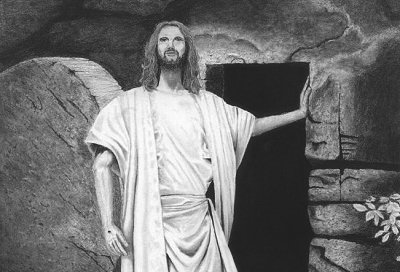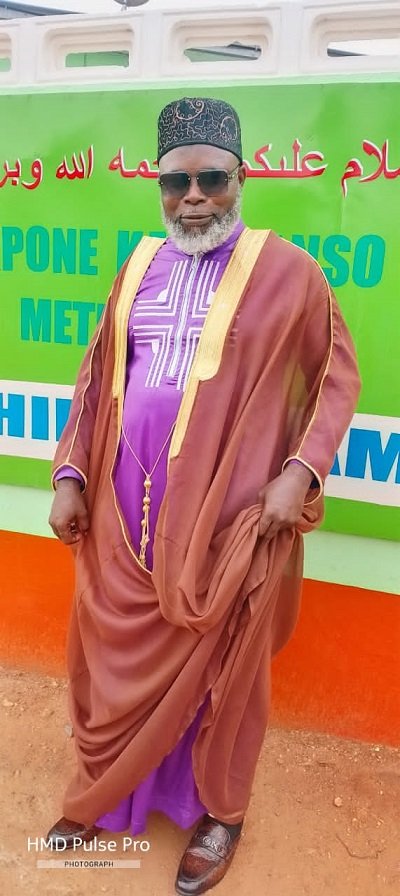Fruitful Living
The significance of the resurrection

He is not here; He has risen, just as He said. Come and see the place where He lay – Matthew 28:6 NIV
INTRODUCTION.
The resurrection of Christ is the supreme miracle. Accept it, and you can accept all the others. It is unique, unlike all other miracles-even the raising of Jairus’s daughter, the widow’s son, and Lazarus. The evidence for the resurrection miracle here is twofold: the empty tomb and His presence with His doubting friends. The body of Jesus, though recognisable by faith, was not bound by time and space.
The two travellers to Emmaus could not recognise Him immediately.
He then “disappeared from their sight.” From Emmaus they returned to the Eleven in Jerusalem, and Jesus appeared suddenly in their midst. The challenge of Jesus to the troubled friends was threefold: (1) touch me, (2) feed me, (3) hear me.
The power of the resurrection continues to strengthen and bless His believing friends. Only Luke, and in Acts 1:19 cites the ascension, perhaps to assure us that His body is a spiritual body. The appearances evoked worship, joy, and praise. The resurrection miracle fulfilled Scripture and Jesus’s own predictions. It is the strongest evidence Jesus is the Messiah promised Israel and the Saviour given to the world.
Here are Four ways the New Testament highlights the significance of the resurrection.
- JESUS’ RESURRECTION MEANS THAT HIS SACRIFICIAL DEATH ON THE CROSS WAS SUFFICIENT, THEREFORE, OUR SINS CAN BE FORGIVEN.
Paul emphasises this in 1 Corinthians 15, reminding us that “Christ died for our sins in accordance with the Scriptures, that He was buried, that He was raised on the third day in accordance with the Scriptures” (vv. 3-4). Then, in verse 17, he argues that “if Christ has not been raised, your faith is futile and you are still in your sins.”
In other words, Paul saw a direct connection between the resurrection of Jesus and the sufficiency of His death to atone for our sins. When Jesus rose again on the third day, it was the public announcement that God was fully satisfied with the sacrificial death of His Son. In His resurrection, Jesus was vindicated, as we read in 1 Timothy 3:16. But in His vindication, we are vindicated too. That’s why Paul says in Romans 4 that Jesus “was delivered up for our trespasses and raised for our justification”- Romans 4:25.
- JESUS’ RESURRECTION MEANS THAT DEATH IS DEFEATED ONCE AND FOR ALL.
As Peter proclaimed on the Day of Pentecost, “God raised Jesus from the dead, freeing Him from the agony of death, because it was impossible for death to keep its hold on Him” – Acts 2:24. Death lost its grip on Jesus!
But the resurrection means that Jesus not only defeated death for Himself, but that He defeated it for us. He died and rose as a new representative for humanity, as the Second Adam. “But in fact Christ has been raised from the dead,” Paul writes, “the first fruits of those who have fallen asleep. For as by a man came death, by a man has come also the resurrection of the dead. For as in Adam all die, so also in Christ shall all be made alive” – 1 Corinthians 15:20-22). His resurrection guarantees ours.
Perhaps no one has said this more eloquently than C. S. Lewis. In his 1947 book “Miracles”, Lewis wrote: “The New Testament writers speak as if Christ’s achievement in rising from the dead was the first event of its kind in the whole history of the universe. He is the ‘first fruits,’ the ‘pioneer of life.’ He has forced open a door that has been locked since the death of the first man. He has met, fought, and beaten the King of Death. Everything is different because He has done so. This is the beginning of the New Creation: a new chapter in cosmic history has been opened.” The empty tomb assures us that sickness and suffering, death and disease will not have the final word.
- JESUS’ RESURRECTION MEANS THAT THE MATERIAL WORLD MATTERS.
Lest there be any misunderstanding, when the apostles said that Jesus rose again, they meant that His physical body came back to life. The risen Jesus wasn’t a phantom or ghost, but a breakfast-eating, flesh-and-bone, human as we read in Luke 24:36-43 and John 21:1 14. As the Pulitzer-Prize winning novelist, John Updike once said,
Make no mistake: if He rose at all it was as His body; if the cells’ dissolution did not reverse, the molecules reknit, the amino acids rekindle, the Church will fall. When Jesus’ came out of the tomb in a physical body, it was God’s definitive stamp of approval on the creation project with all of its materiality. The resurrection shows us that matter matters. And this is why the early Christians looked to the future with confidence that the created order itself would be redeemed as we read in Romans 8:18-25.
Though we wait for the full consummation of new creation, the Scriptures also teach that the power that raised Jesus from the dead is already working within us as we read in Ephesians 1:19-20. The resurrection, you see, not only assures of God’s forgiveness and comforts us in suffering as we anticipate the final reversal of death, disease, and decay; it motivates and empowers us to push back the tide of suffering and evil in the present world, through word and deed, in mercy and in justice, all in Jesus’ name.
Jesus embodied and demonstrated the oxymoron of the crucified life, that a self-centred life is misery, and that genuinely abundant living occurs only when one dies to self-interest as we read in Matthew 10:38-39; 16:24-28; 20:26-28; 23:12. Paul developed this further, teaching us that Jesus’ followers died with Him to the old life and arose with Him to life anew as we read in Romans 6:1-11. But this transformative model of the cross leading to the crown is a farce if Jesus’ suffering did not lead to His resurrection and heavenly reign. Paul’s basis for teaching the Philippians to live in humility and unity is simply to tell the story of Jesus, centring on how His past humility led to His future exaltation as we read in Philippians 2:1-13.
End Piece
The Gospel of Luke also records Jesus’s resurrection and the women’s obedience in relaying the angel’s message to the rest of the disciples. Luke also gives us details into Jesus’s post – resurrection appearances, which proved His resurrection and provided Him the opportunity to give final charges to His disciples before ascending to heaven. Jesus appeared to two disciples on the road to Emmaus, when He also confirmed that all of Scripture points to Himself. Jesus later appeared to the Apostles and showed them His hands and feet. He prompted them to believe the resurrection by eating with them and interpreting the Old Testament in light of His sufferings and resurrection. Jesus identified Himself as the Messiah. His time on earth ended with a commission to His disciples. He left them with the charge to minister and proclaim the gospel on Jesus’s behalf. As Jesus’s disciples today, we know Him because others have been faithful to carry His gospel around the world, and we pick up where those disciples left off as Jesus’s faithful ambassadors.
- INVITATION
If you have not yet confessed Jesus as your Lord and personal Saviour, this is an opportunity to do so. And when you do, just surrender totally to Him with your eternal future, for He will never leave nor forsake you – Hebrews 13:5
STAY BLESSED!
For further inquiries please contact us on Tel Nos. 0243588467 or 0268130615
Email: saltnlightministries@gmail.com
Website: saltandlightministries.org
By Dr Joyce Aryee, the author
Fruitful Living
Eid-ul-Adha: A living legacy of faith, sacrifice, and devotion

We begin in the name of Allah, the Most Merciful, the Most Compassionate. We praise Him, seek His help and forgiveness, and seek refuge in Him from the evils of our souls and the wrongs of our actions.
May peace and blessings be upon the Prophet Muhammad (peace be upon him), his family, his noble companions, and all those who follow his path until the Day of Judgment.
Understanding the essence
of Eid-ul-Adha
Eid-ul-Adha, the Festival of Sacrifice, is one of the two major Islamic celebrations observed by Muslims across the world.
It commemorates the unwavering submission of Prophet Ibrahim (Abraham, peace be upon him) to Allah’s command when he was prepared to sacrifice his beloved son Isma’il (Ishmael, peace be upon him). Allah, in His infinite mercy, intervened and replaced the son with a ram, thus honouring Ibrahim’s sincerity and faith.
This moment of sacrifice is recorded in the Qur’an: “Then when they had both submitted and he put him down upon his forehead, We called out: ‘O Ibrahim! You have fulfilled the vision.’ Indeed, We thus reward the doers of good.” (Surah As-Saffat, 37:103–105)
This act of obedience is not merely a historical account. It is a living symbol that forms the essence of Eid-ul-Adha.
Ibrahim (A.S): The Architect
of Submission
Before the moment of sacrifice, Prophet Ibrahim and his family played critical roles in establishing Islam’s foundational pillars:
1. The building of the Ka‘bah
Prophet Ibrahim and his son Isma’il were chosen to construct the Ka‘bah, the sacred House of Allah in Makkah. The Qur’an records this noble moment:
“And [mention] when Ibrahim was raising the foundations of the House and [with him] Isma’il, [saying], ‘Our Lord, accept [this] from us. Indeed, You are the Hearing, the Knowing.’”
(Surah Al-Baqarah 2:127)
This structure remains the spiritual centre of Muslim worship, facing which over a billion Muslims direct their daily prayers.
2. The struggle of Hajar (Hajara) between Safa and Marwa
The mother of Isma’il, Hajar (Hajara), exemplifies a profound lesson of patience and faith. Left in the barren valley of Makkah with her infant, she ran between the hills of Safa and Marwa, desperately searching for water. Her perseverance was rewarded when the well of Zamzam sprang forth at the feet of her baby.
Her sincere struggle is now ritualised in Hajj as the Sa‘i between Safa and Marwa—a reminder of the role of women, the power of du‘a, and the value of trust in Allah’s provision.
Sacrifice at Mina and the
Rites of Jamarat
During Hajj, pilgrims reenact Ibrahim’s confrontation with Shaytan at Mina, where he rejected the devil’s temptation and cast stones at him. This act is now observed in Hajj as the ritual of stoning the Jamarat, symbolising the rejection of evil, temptation, and disobedience.
It is a vivid spiritual lesson: the path to Allah is one of resistance to distraction and sin, and one must be prepared to fight these forces with unwavering faith.
The essence of Arafat in Hajj
The Prophet Muhammad said:“Hajj is Arafah.” (Sunan al-Tirmidhi, 889)
Standing on the plain of Arafat, in deep humility and supplication, is the heart of Hajj. It represents the Day of Judgment, when all of humanity will stand before their Creator. The Prophet said: “There is no day on which Allah frees more people from the Fire than the Day of Arafah.” (Sahih Muslim, 1348)
For pilgrims, Arafat is a time of repentance, reflection, and renewal— and for non-pilgrims, fasting on that day is highly recommended.
Three core lessons from the
Sacrifice of Prophet Ibrahim
(A.S.)
1. Absolute obedience to Allah
Ibrahim’s willingness to sacrifice his son teaches that the essence of faith is unquestioning obedience to Allah. He prioritised divine command over emotion, logic, or comfort.
Takeaway:
In our lives, we must also be ready to put aside our desires, egos, and even attachments if they conflict with Allah’s instructions. This may involve sacrifices such as waking up for Fajr, staying away from haram income, or being truthful in difficult situations.
2. Sincere intention and inner sacrifice
The real essence of the sacrifice lies in the heart’s submission to Allah.
It is neither their meat nor their blood that reaches Allah, but it is your piety that reaches Him.”
(Surah Al-Hajj 22:37)
Takeaway:
Every act of worship should be grounded in sincerity. Whether it is prayer, charity, or sacrifice, what matters most is the purity of our intention.
3. Sacrifice for the greater good
The legacy of Eid-ul-Adha teaches us that sometimes, faith requires us to give up what we love for a greater purpose. Sacrificing wealth, time, or status in the path of Allah or for the benefit of others leads to spiritual elevation.
Takeaway:
Use your resources such as time, money, skills, for acts of benefit: support the poor, educate the young, assist the sick, and build your community.
Celebrating Eid-ul-Adha: A
Festival for all Muslims
Even for those who do not go on Hajj, Eid-ul-Adha holds immense significance. Muslims across the world participate in the act of Qurbani (sacrifice) to honor the tradition of Ibrahim (A.S.).
Types of animals and their
symbolism
Permissible animals include goats, sheep, cows, and camels. Each must meet a minimum age and be free of defects. The sacrificed animal is then divided into three parts: one for the family, one for relatives and friends, and one for the poor and needy.
This distribution reflects the spirit of sharing, compassion, and social responsibility—values at the heart of Islam.
The eternal message of Eid-ul-Adha
Eid-ul-Adha is not merely a celebration; it is a living tradition that calls us to:
• Submit like Ibrahim,
• Strive like Hajar,
• Sacrifice like Isma’il,
• Reflect like the pilgrims at Arafat.
May this Eid awaken within us a renewed commitment to obedience, sincerity, and compassion.
Let us make every Eid-ul-Adha a step forward in our spiritual journey, embodying the values of submission, sacrifice, and service to humanity. I wish every Muslim Eid Mubaarak
By Imaam Alhaji Saeed Abdulai
(Kpone Katamanso Metropolitan Chief Imaam)
Fruitful Living
Steps taken by government to combat illicit drugs (Final part)
The Minister for the Interior, Muntaka Mohammed-Mubarak, has reaffirmed the government’s commitment to combating drug abuse and illicit trafficking for a safer environment which would
go a long way to make Ghana a drug-free country. 3News.com (2025)
Solutions to Illicit Drugs from the Islamic perspective
are comprehensive and emphasise of both prevention and treatment:
Tarbiyah (Islamic nurturing): Instilling strong Islamic values from childhood through Qur’anic education, regular prayer, and association with righteous companions.
Community preaching (Da’wah): Imams must consistently raise awareness during khutbahs and Islamic programs about the dangers of drugs and the beauty of a sober, productive life.
Faith-based rehabilitation: Mosques and Islamic centers can partner with medical institutions to offer Qur’an therapy, spiritual counseling, and structured recovery programs.
Islamic youth clubs: Providing youth with halal entertainment, mentorship, and purposeful engagement can steer them away from harmful peer groups.
Zakat and Sadaqah: Channelling funds to support families of victims and establishing centres for rehabilitation.
Role of Parents, Society, Muslim Chiefs and Imams:
Parents must be vigilant and provide emotional support. A loving, nurturing home reduces a child’s vulnerability to drugs.
Society should de-stigmatize addiction. Drug users should be seen as patients needing healing, not criminals deserving rejection.
Muslim Chiefs must lead community campaigns, setting moral examples and supporting policy enforcement.
Imams must be more than religious leaders—they must become counsellors, educators, and advocates. Their leadership can shift public perception and guide collective action.
Conclusion
Illicit drugs pose one of the most dangerous threats to our society, undermining our religious values, harming our youth, and destroying our future. The Islamic position is clear and
Unequivocal: such substances are forbidden due to their destructive consequences on all aspects of life. Islam does not merely condemn the act but calls for a holistic response—spiritual, social, and structural.
As a society, particularly as Muslims, we must rise to confront this crisis with faith, compassion, and commitment. We must not only preach against drugs but actively work to rehabilitate victims, educate the next generation, and partner with public institutions to create a society of wellness and righteousness.
Recommendations
1. Introduce Islamic drug awareness education in madrasas and public schools, using Quran and Hadith-based materials to instill moral responsibility.
2. Create partnerships between the Ghana Narcotics Control Commission, Ghana Health Service, and Muslim organisations to develop culturally sensitive rehabilitation centres.
3. Train Imams and teachers in basic mental health and drug abuse counselling to serve as front-line responders in communities.
4. Utilise Friday sermons (khutbahs) nationwide to address the dangers of drug abuse periodically and provide practical steps for prevention.
5. Encourage community surveillance, where parents, chiefs, and youth groups report dealers and suspicious activities to the authorities.
6. Establish mentorship programmes in every Muslim community where successful, drug-free role models mentor youth.
7. Form interfaith coalitions, working across religious lines to tackle the drug menace as a national threat rather than a religious issue.
8. Provide job skills training for rehabilitated victims, helping them reintegrate into society and live dignified, self-sufficient lives.
By Imam Alhaji Saeed Abdulai, the Author







